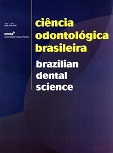Efeito da incorporação de hipoclorito de cálcio em gesso tipo III sobre a estabilidade dimensional, resistência à tração diametral e a compressão
DOI:
https://doi.org/10.14295/bds.2009.v12i1.254Abstract
Neste trabalho foram analisadas as possíveis alterações promovidas pela incorporação de agentes desinfetantes na resistência à compressão, estabilidade dimensional linear e resistência à tração diametral de modelos em gesso. As amostras foram confeccionadas em gesso pedra tipo III e divididas nos seguintes grupos: Grupo 1- controle (espatulado de acordo com as recomendações do fabricante); Grupo 2- adição de 0,5 % de hipoclorito de cálcio; Grupo 3- adição de 1,0 % de hipoclorito de cálcio; Grupo 4- adição de 1,5 % de hipoclorito de cálcio. Baseado nos resultados obtidos pode se observar que a incorporação de hipoclorito de cálcio influenciou negativamente nos valores de resistência a tração diametral do gesso avaliado, aspecto também observado na resistência a compressão com a incorporação de hipoclorito de cálcio 1,5%. A análise da estabilidade dimensional demonstrou que o agente desinfetante promoveu uma diminuição na expansão de presa apresentada pelo gesso. Com isso, concluímos que a incorporação de hipoclorito de cálcio promove uma tendência à diminuição da expansão apresentada durante a presa do gesso, porém esta incorporação acarreta uma diminuição na resistência dos modelos de gesso.
Downloads
Downloads
Published
How to Cite
Issue
Section
License
Brazilian Dental Science uses the Creative Commons (CC-BY 4.0) license, thus preserving the integrity of articles in an open access environment. The journal allows the author to retain publishing rights without restrictions.
=================




























